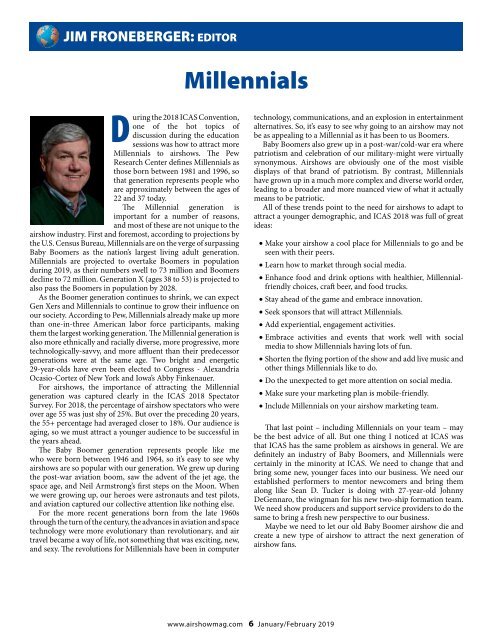2019-01-LR-Final
You also want an ePaper? Increase the reach of your titles
YUMPU automatically turns print PDFs into web optimized ePapers that Google loves.
JIM FRONEBERGER: EDITOR<br />
Millennials<br />
During the 2<strong>01</strong>8 ICAS Convention,<br />
one of the hot topics of<br />
discussion during the education<br />
sessions was how to attract more<br />
Millennials to airshows. The Pew<br />
Research Center defines Millennials as<br />
those born between 1981 and 1996, so<br />
that generation represents people who<br />
are approximately between the ages of<br />
22 and 37 today.<br />
The Millennial generation is<br />
important for a number of reasons,<br />
and most of these are not unique to the<br />
airshow industry. First and foremost, according to projections by<br />
the U.S. Census Bureau, Millennials are on the verge of surpassing<br />
Baby Boomers as the nation’s largest living adult generation.<br />
Millennials are projected to overtake Boomers in population<br />
during <strong>2<strong>01</strong>9</strong>, as their numbers swell to 73 million and Boomers<br />
decline to 72 million. Generation X (ages 38 to 53) is projected to<br />
also pass the Boomers in population by 2028.<br />
As the Boomer generation continues to shrink, we can expect<br />
Gen Xers and Millennials to continue to grow their influence on<br />
our society. According to Pew, Millennials already make up more<br />
than one-in-three American labor force participants, making<br />
them the largest working generation. The Millennial generation is<br />
also more ethnically and racially diverse, more progressive, more<br />
technologically-savvy, and more affluent than their predecessor<br />
generations were at the same age. Two bright and energetic<br />
29-year-olds have even been elected to Congress - Alexandria<br />
Ocasio-Cortez of New York and Iowa’s Abby Finkenauer.<br />
For airshows, the importance of attracting the Millennial<br />
generation was captured clearly in the ICAS 2<strong>01</strong>8 Spectator<br />
Survey. For 2<strong>01</strong>8, the percentage of airshow spectators who were<br />
over age 55 was just shy of 25%. But over the preceding 20 years,<br />
the 55+ percentage had averaged closer to 18%. Our audience is<br />
aging, so we must attract a younger audience to be successful in<br />
the years ahead.<br />
The Baby Boomer generation represents people like me<br />
who were born between 1946 and 1964, so it’s easy to see why<br />
airshows are so popular with our generation. We grew up during<br />
the post-war aviation boom, saw the advent of the jet age, the<br />
space age, and Neil Armstrong’s first steps on the Moon. When<br />
we were growing up, our heroes were astronauts and test pilots,<br />
and aviation captured our collective attention like nothing else.<br />
For the more recent generations born from the late 1960s<br />
through the turn of the century, the advances in aviation and space<br />
technology were more evolutionary than revolutionary, and air<br />
travel became a way of life, not something that was exciting, new,<br />
and sexy. The revolutions for Millennials have been in computer<br />
technology, communications, and an explosion in entertainment<br />
alternatives. So, it’s easy to see why going to an airshow may not<br />
be as appealing to a Millennial as it has been to us Boomers.<br />
Baby Boomers also grew up in a post-war/cold-war era where<br />
patriotism and celebration of our military-might were virtually<br />
synonymous. Airshows are obviously one of the most visible<br />
displays of that brand of patriotism. By contrast, Millennials<br />
have grown up in a much more complex and diverse world order,<br />
leading to a broader and more nuanced view of what it actually<br />
means to be patriotic.<br />
All of these trends point to the need for airshows to adapt to<br />
attract a younger demographic, and ICAS 2<strong>01</strong>8 was full of great<br />
ideas:<br />
• Make your airshow a cool place for Millennials to go and be<br />
seen with their peers.<br />
• Learn how to market through social media.<br />
• Enhance food and drink options with healthier, Millennialfriendly<br />
choices, craft beer, and food trucks.<br />
• Stay ahead of the game and embrace innovation.<br />
• Seek sponsors that will attract Millennials.<br />
• Add experiential, engagement activities.<br />
• Embrace activities and events that work well with social<br />
media to show Millennials having lots of fun.<br />
• Shorten the flying portion of the show and add live music and<br />
other things Millennials like to do.<br />
• Do the unexpected to get more attention on social media.<br />
• Make sure your marketing plan is mobile-friendly.<br />
• Include Millennials on your airshow marketing team.<br />
That last point – including Millennials on your team – may<br />
be the best advice of all. But one thing I noticed at ICAS was<br />
that ICAS has the same problem as airshows in general. We are<br />
definitely an industry of Baby Boomers, and Millennials were<br />
certainly in the minority at ICAS. We need to change that and<br />
bring some new, younger faces into our business. We need our<br />
established performers to mentor newcomers and bring them<br />
along like Sean D. Tucker is doing with 27-year-old Johnny<br />
DeGennaro, the wingman for his new two-ship formation team.<br />
We need show producers and support service providers to do the<br />
same to bring a fresh new perspective to our business.<br />
Maybe we need to let our old Baby Boomer airshow die and<br />
create a new type of airshow to attract the next generation of<br />
airshow fans.<br />
www.airshowmag.com 6 January/February <strong>2<strong>01</strong>9</strong>




